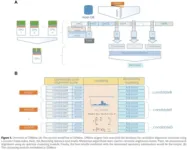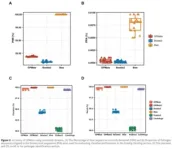(Press-News.org) **Strictly embargoed until 01:01 (BST) Wednesday 26 April 2023**
Astronomers solve the 60-year mystery of quasars – the most powerful objects in the Universe
First discovered 60 years ago, quasars can shine as brightly as a trillion stars packed into a volume the size of our Solar System, but until now it has remained a mystery what could trigger such powerful activity
By observing 48 galaxies that host quasars and comparing them to over 100 non-quasar galaxies, scientists discovered that the phenomenon is ignited by galaxies colliding
When two galaxies collide, gravitational forces push huge amounts of gas towards supermassive black holes at the centre of the remnant galaxy system that results from the collision – just before the gas is consumed by the black hole, it releases extraordinary amounts of energy in the form of radiation, resulting in a quasar
The Milky Way is likely to experience its own quasar when it collides with the Andromeda galaxy in roughly five billion years’ time
Scientists have unlocked one of the biggest mysteries of quasars – the brightest, most powerful objects in the Universe – by discovering that they are ignited by galaxies colliding.
First discovered 60 years ago, quasars can shine as brightly as a trillion stars packed into a volume the size of our Solar System. In the decades since they were first observed, it has remained a mystery what could trigger such powerful activity. New work led by scientists at the Universities of Sheffield and Hertfordshire has now revealed that it is a consequence of galaxies crashing together.
The collisions were discovered when researchers, using deep imaging observations from the Isaac Newton Telescope in La Palma, observed the presence of distorted structures in the outer regions of the galaxies that are home to quasars.
Most galaxies have supermassive black holes at their centres. They also contain substantial amounts of gas – but most of the time this gas is orbiting at large distances from the galaxy centres, out of reach of the black holes. Collisions between galaxies drive the gas towards the black hole at the galaxy centre; just before the gas is consumed by the black hole, it releases extraordinary amounts of energy in the form of radiation, resulting in the characteristic quasar brilliance.
The ignition of a quasar can have dramatic consequences for entire galaxies – it can drive the rest of the gas out of the galaxy, which prevents it from forming new stars for billions of years into the future.
This is the first time that a sample of quasars of this size has been imaged with this level of sensitivity. By comparing observations of 48 quasars and their host galaxies with images of over 100 non-quasar galaxies, researchers concluded that galaxies hosting quasars are approximately three times as likely to be interacting or colliding with other galaxies.
The study has provided a significant step forward in our understanding of how these powerful objects are triggered and fuelled.
Professor Clive Tadhunter, from the University of Sheffield’s Department of Physics and Astronomy, said: “Quasars are one of the most extreme phenomena in the Universe, and what we see is likely to represent the future of our own Milky Way galaxy when it collides with the Andromeda galaxy in about five billion years.
“It’s exciting to observe these events and finally understand why they occur – but thankfully Earth won’t be anywhere near one of these apocalyptic episodes for quite some time.”
Quasars are important to astrophysicists because, due to their brightness, they stand out at large distances and therefore act as beacons to the earliest epochs in the history of the Universe. Dr Jonny Pierce, Post-Doctoral Research Fellow at the University of Hertfordshire, explains:
“It’s an area that scientists around the world are keen to learn more about – one of the main scientific motivations for NASA’s James Webb Space Telescope was to study the earliest galaxies in the Universe, and Webb is capable of detecting light from even the most distant quasars, emitted nearly 13 billion years ago. Quasars play a key role in our understanding of the history of the Universe, and possibly also the future of the Milky Way”.
Ends
For more information please contact:
George Dean, Media and PR Assistant, University of Sheffield, 07984 335211, g.r.dean@sheffield.ac.uk
END
Astronomers solve the 60-year mystery of quasars – the most powerful objects in the Universe
2023-04-26
ELSE PRESS RELEASES FROM THIS DATE:
Social media fuelling eating disorders among female athletes, research shows
2023-04-26
Social media is fuelling eating disorders among female athletes who feel they must achieve the ‘ideal’ body, according to experts.
Dr Kathryn Vidlock and Catherine Liggett, who have both competed in collegiate athletics, and dietician Andrew Dole warn that nutrition ‘myths’ posted by fitness influencers, exercise-related ‘fitspiration’ images on Instagram, and photoshopping are having a direct impact on sportswomen.
Their new book Spring Forward: Balanced Eating, Exercise, and Body Image in ...
App users wary of health and fitness recommendations based on social media data
2023-04-25
UNIVERSITY PARK, Pa. — People may appreciate online apps that provide advice on health and fitness, but they seem to draw the line when those apps use their social media networks for data, according to researchers.
In a study, users showed a strong preference for fitness recommendations that were personalized for them based on their self-reported preferences. They also liked systems that allowed users to choose among different recommendation approaches, which made them feel more in control.
“As big data gives people new opportunities to personalize their health and fitness routines, it also calls into question how ...
Estimated 6.5 million Californians know someone at risk of harming themselves, others
2023-04-25
(SACRAMENTO, Calif.) — One in five adults in California, or an estimated 6.5 million people, are concerned that someone they know, usually a friend or family member, is at risk of harming themselves or others, according to new research published in Preventive Medicine.
Alcohol and substance misuse, a history of violence, and firearm access were common reasons for concerns about potential violence.
Of the people perceived to be at risk for harming others, an estimated 19% were said to have access to firearms. For those perceived to be at risk of harming themselves, that number was approximately 11%.
Amanda J. Aubel, a research data analyst at the UC Davis Violence Prevention Research ...
Autistic children exhibit aggression more frequently, study shows
2023-04-25
At least half of all autistic children experience some form of aggression, such as hitting, kicking or name-calling, while their parents are tasked with helping them cope and integrate socially. Yet the prevalence and characterization of aggressive behaviors across autistic development are poorly understood.
To address this knowledge gap, researchers in the Family and Community Intervention Lab at the University of Arkansas compared autistic children to non-autistic children on different types of aggressive behaviors over three ...
Registration opens for 2023 International Space Station Research and Development Conference in Seattle
2023-04-25
Registration is now open for the 12th annual International Space Station Research and Development Conference (ISSRDC), July 31-August 3, 2023, at the Hyatt Regency Hotel in Seattle, Washington.
ISSRDC brings together leaders from the commercial sector, U.S. government agencies, and academic communities to foster innovation and discovery onboard the International Space Station (ISS). ISSRDC 2023 will showcase how the space station continues to provide a valuable
platform for research ...
New iPad app lets doctors assess components of cognition in five minutes or less
2023-04-25
More than 50 tests span cognition, motor, sensation and emotion to assess a wide range of diseases
‘The problem in clinical care today is nobody has time for long tests for everything’
Earlier version of app now used by 3,000 researchers globally (e.g. COVID ‘brain fog’)
CHICAGO --- An iPad app developed at Northwestern Medicine that helps measure specific aspects of cognitive, motor, sensory and emotional function in five minutes or less is now available for doctors to screen people ages 3 to 85+ for a wide range of neurological diseases and syndromes.
Using the NIH Toolbox® V3 iPad App, ...
Presenting information about mental health in a second language could help counter cultural norms against treatment
2023-04-25
Public health outreach efforts often strive to overcome communication barriers by using interpretation and translation to present information to communities in their native language. However, bilingual people from cultural backgrounds in which mental health is a particularly taboo topic may be more likely to support treatment when they hear information in their second language, said Leigh H. Grant (University of Chicago) about her findings in Clinical Psychological Science.
Chinese speakers with English as second language “were consistently ...
Researchers capture first atomic-scale images depicting early stages of particle accelerator film formation
2023-04-25
Researchers from Prof. Steve Sibener's group have captured the first atomic-scale images of tin on niobium during the growth process of the next generation of particle accelerators, Nb3Sn.
The study, published in the Journal of Physical Chemistry C, reveals the potential for greater control over the growth of superconducting Nb3Sn films, which could significantly reduce the cost and size of cryogenic infrastructure required for superconducting technology.
Superconducting accelerator facilities, such as those used for X-ray free-electron laser radiation, rely on niobium superconducting ...
Thich Nhat Hanh Center for Mindfulness in Public Health launched at Harvard T.H. Chan School of Public Health
2023-04-25
Boston, MA – The Thich Nhat Hanh Center for Mindfulness in Public Health will launch April 26 at the Harvard T.H. Chan School of Public Health. The Center was created with a $25 million gift from an anonymous donor, one of the largest single donations to the School.
The Center’s mission is to empower people around the globe to live with purpose, equanimity, and joy through the practice of mindfulness; pursue evidence-based approaches to improve health and well-being through mindfulness; and educate and train the public in mindfulness. Two primary areas of emphasis will be nutrition and the environment.
“We are thrilled to host this groundbreaking ...
What is the best lymphoma treatment after CAR T therapy fails?
2023-04-25
For 30% to 40% of lymphoma patients who receive CAR T therapy, the treatment is a godsend. Typically given to lymphoma patients for whom other treatments have proven ineffective, CAR T therapy involves removing immune cells from the body via a blood draw, reengineering them to become better cancer fighters, then reintroducing them to the bloodstream, where they seek out and destroy cancer cells.
For 60% to 70% of lymphoma patients who receive CAR T therapy, however, the treatment doesn’t work, and the cancer comes back — typically within ...




